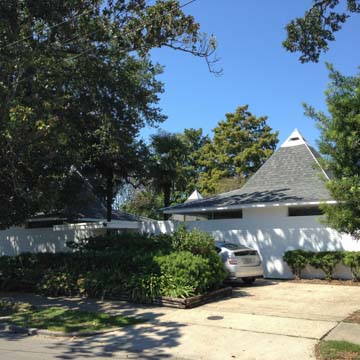Built for a young pediatrician and his family, this house is composed of four pavilions identical in size and form, connected by glazed passageways that define two interior courtyards, one for meditation and the other for recreation. Each of the pavilions serves a specific use, as specified by the clients: living, dining and food preparation, children’s space, and parents’ space. Each pavilion has a pyramidal roof of wood and steel. Windows on the exterior brick walls are small and high to ensure privacy, and all large glassed areas face inward to the courtyards. New Orleanian Charles Colbert (1921–2007), dean of Columbia University School of Architecture from 1960 to 1963, said of his modern design, “I have attempted to recall the earlier forms of architecture in Louisiana, maintain a reasonably constant residential scale, and repeat some of the roof forms of the immediate environs.” The house was widely published in architecture journals.
You are here
Henry G. Simon House
If SAH Archipedia has been useful to you, please consider supporting it.
SAH Archipedia tells the story of the United States through its buildings, landscapes, and cities. This freely available resource empowers the public with authoritative knowledge that deepens their understanding and appreciation of the built environment. But the Society of Architectural Historians, which created SAH Archipedia with University of Virginia Press, needs your support to maintain the high-caliber research, writing, photography, cartography, editing, design, and programming that make SAH Archipedia a trusted online resource available to all who value the history of place, heritage tourism, and learning.


